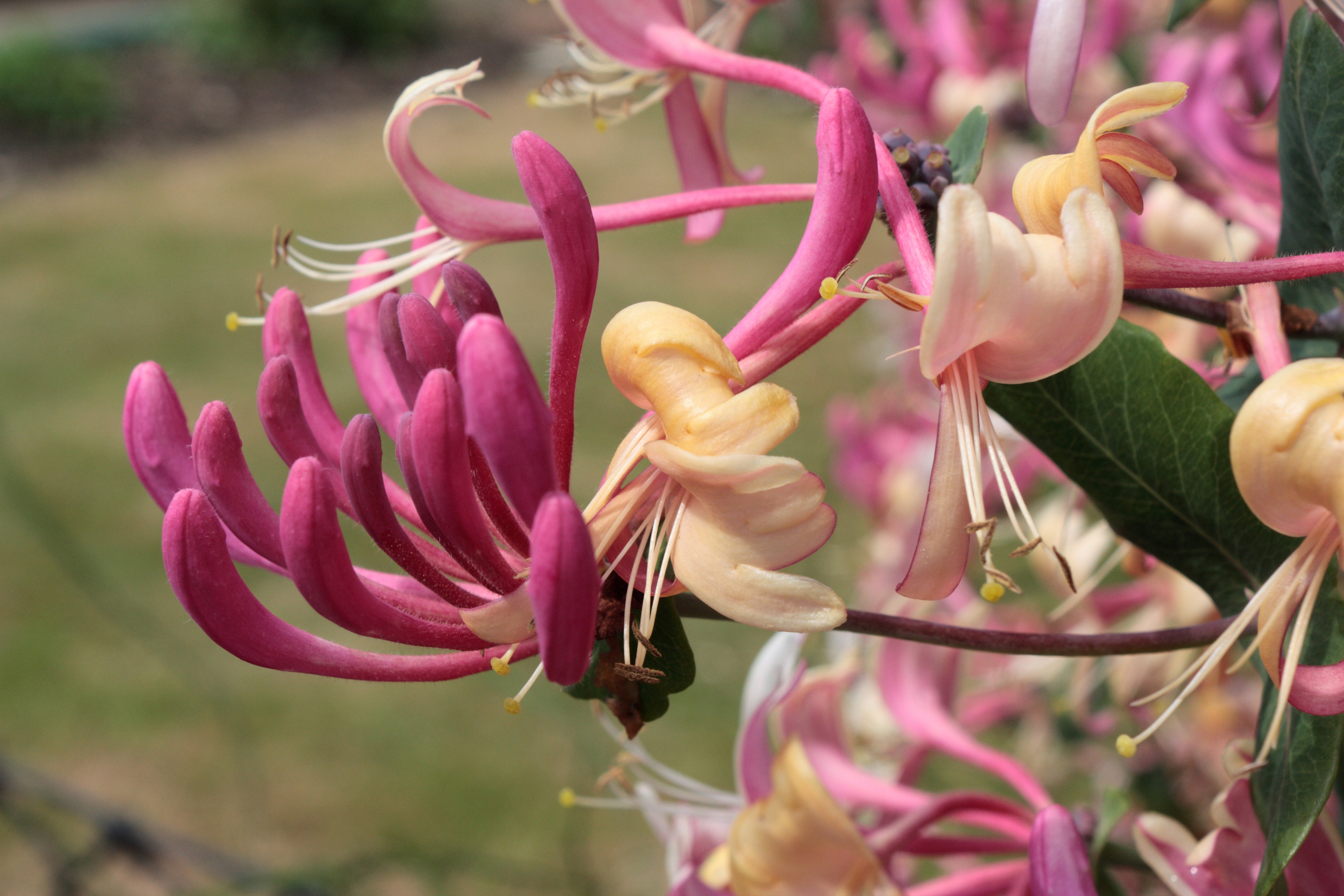Peter’s Gardening tips for June
Summer arrives at last, Roses, Peonies, Lavenders, Honeysuckles, Philadelphus (mock orange), the smells are intoxicating – go and have a sniff!
Growth is still exceptional on everything including the weeds!! Lush, exuberant, unbelievably bonkers, and mad!
What are the best parts of your garden and give you the greatest pleasure? For me it’s the Japanese Acers, Flowering Dogwoods, mixed with Roses and Clematis, Peonies, Lupins, Catmint in the back garden with all the baby birds feeding from the feeders.
Fantastic breeding season for the birds, one pair of blackbirds are on their third brood! Keep feeding the birds, fatballs, black sunflower, sunflower hearts, mealworms and high energy foods.
In the front garden it’s the wildflowers growing in the gravel, masses of bees especially bumblebees.
Check out the BBC Springwatch website, great coverage of all things to do with natural history and bio-diversity. I hope you enjoyed the series – I learnt loads.
Vegetables
Back to gardening, a few weeks ago I was lucky enough to go to Belmond Le Manoir aux Quat’ Saisons– Raymond Blanc’s hotel and restaurant in Oxfordshire. On crutches, we had a guided tour around the gardens in one and a half-acre of organic-walled vegetable garden by Anna Greenland, Head of Vegetables.
Sea Kale is a must-grow vegetable if you have the room, it’s perennial – comes up every year, you can even force it like rhubarb. The blanched stems are delicious steamed or braised with butter, salt and pepper. The flowers are edible too and smell and taste of honey, its from the cabbage family, easy to grow and best from seed.
Potatoes
A fabulous array of potatoes including many of my favourites for flavour, Ratte, Belle de Fontenay, Pink fir apple, Charlotte, Maris Peer- personally tastier than Jersey Royals (international Kidney). Whilst mentioning the humble spud, please spray for potato blight as a precaution with warm, humid weather on its way. Traditional Copper fungicide or Bordeaux mixture will keep this disastrous and devastating fungal disease at bay. Also, spray any tomato plants outside as it affects them too – they are in the same plant group, Solanum. Keep potato plants free of weeds and airy, wet foliage touching the ground will encourage potato blight, its best to water in the morning if you can?
Green manures are used between crops to improve soil fertility, such as Phacelia. Carrot root fly is kept at bay by a wall of fleece or Environmesh, 30 cms tall around blocks of carrots planted at ground level.
The gardens were an absolute joy, fabulously well laid out with impeccable taste, intrigue, design and imagination. Raymond Blancs attention to’ Les Petits Details’ is extraordinary with his gardening team Anne-Marie Owens and Anna Greenland to name but a few. Chris Beardshaw is also designing a new garden around some beautiful majestic old apple trees.
Lunch was something else! Never to be forgotten….
Jobs to do
Seed Sowing
Still not too late to sow beans – climbing French, runner beans, French beans, peas, squash, courgette, sweetcorn . Some of the best runner beans are planted in July producing a late autumn crop. All salad crops can be sown – cover with fleece/environmesh to keep bugs off, reduce scorching of leaves and drying out.
Fruit
Looking like another bumper crop, Peaches and Plums – too many fruit set. Thin them out and allow 2-3 inches between fruit. It looks and sounds brutal but you will end up with better quality fruit, larger and less prone to disease. Pick off curly blistered leaves on Peach trees. Give a weekly soak and feed to your fruit trees to stop the June drop, seaweed liquid feed or tomato feed. A lot of woolly aphid and greenfly/aphids on fruit trees this year as mentioned in last months article, ‘Bugs and Beasties’. To avoid the birds taking away the fruit on Cherry trees, hang old cd’s on string to scare away in a nice way, ah…?
Greenhouse
Keep tying in cucumbers and tomatoes securely, plants get incredibly heavy once the fruit swells. De-shoot tomato plants, side shoots between the main stem and the leaf, pinch these out. Keep fed and watered on a regular basis, again mornings are best. Shade your greenhouse if you have one with cool glass, a white wash for glass, and it comes off best with a soft broom and water at the end of the season.
Pruning
Any shrubs that have finished flowering recently can be pruned:- Deutzia, Kolwitzia, Weigelia, Philadelphus (mock orange), Viburnums. Buddleias can be trimmed back if growth is too lush and strong. This will encourage more branching, more flower and staggering of flowers. Rhododendrons and Azaleas can be pruned – on smooth bark stemmed rhododendrons only a trim. On rough barked ones you can be more severe with the pruning.
Clematis montana can be given a good haircut now – check for bird nests. Try and keep some new stems to replace the old growth for next years flowers.
Evergreen and variegated shrubs
Choisya, Elaeagnus can all be pruned. Cut out any stems on variegated shrubs or trees that have reverted back to green. Follow the stem back and remove completely. If left the green branch will ultimately take over!
Suckers :- Roses,Viburnams base of fruit trees, Wisterias- Go on a sucker hunt- tear off if possible, but definitely remove.
Hedges
Box hedges, June is the month BUT only when no rain is forecast and it is not too hot, to prevent box blight. Clean all cutting equipment before starting, wipe down and spray with WD40, put down sheets to collect the clippings. Afterwards blast the hedge with a leaf blower to get the loose rubbish out of the hedge. Water afterwards at the base of the hedge with liquid seaweed plant food.
Other hedges – only trim if you have too, there are still a lot of birds nesting.
Feeding & Watering
All plants in containers will need regular watering and feeding, anything with fruit or flowers feed with high potash plant food, tomato feed, miracle gro, Phostrogen or organic feeds.
Trees, shrubs, perennials and hedges use a granular fertiliser such as Vitax Q4 or Grow more.
Any newly planted trees and shrubs must be watered for the first year –even plants planted last autumn! Wind is the worst culprit of drying plants out.
Dead Heading
Something often over looked- the removal of dead flowers. Do this once a week at least. This not only promotes more flowers but stops the plant producing seeds, which exhausts the parent plant . Make sure all the old flower spike is removed- cut down to healthy new leaves or flower buds. Roses, Lupins, Clematis, Foxgloves………If it’s dead or looking rough cut it out!
Here endeth the lesson!
Happy Gardening from Hop Along Pete -Still on crutches, back to hospital on 25th of June.
Take time out, sit in your garden or allotment , enjoy your hard work, Stop, Look, Listen, Sniff and have a drink! What a good idea – I’m Off!!
PS: Don’t forget go garden visiting –Stately homes and The Yellow Book-National Garden Scheme!
RHS Hampton Court Flower Show 8th -13th of July.
RHS Flower Show Tatton Park 23rd -27th of July.
Peter Mills
Silversurfers Gardening Editor
Latest posts by Peter Mills (see all)
- Peter’s Gardening tips for November - October 29, 2024
- Peter’s Gardening tips for October - October 1, 2024
- Peter’s Gardening Tips for September 2024 - August 29, 2024
- Peter’s Gardening Tips for August - August 1, 2024
- Peter’s Gardening Tips for July - July 1, 2024

























